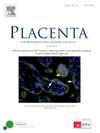用激光散斑对比成像评估妊娠早期胎盘生长因子水平与皮肤微血管反应性的相关性——一项横断面研究
IF 3
2区 医学
Q2 DEVELOPMENTAL BIOLOGY
引用次数: 0
摘要
目的通过激光散斑对比成像(LSCI)联合闭塞后反应性充血,探讨妊娠早期胎盘生长因子(PlGF)水平与母体皮肤微血管反应性之间的关系。此外,探讨母体微血管功能与其他妊娠早期血清生化和生物物理指标的相关性。方法对53例单胎妊娠患者进行妊娠早期常规扫描。在动脉闭塞3分钟之前、期间和之后,用LSCI记录手背皮肤血流量。计算微血管反应性参数,并将其与母体血清生化指标(PlGF、妊娠相关血浆蛋白A [ppap -A]、游离β-人绒毛膜促性腺激素[游离β-hCG])进行比较,这些指标以中位数的倍数表示,并与母体生物物理指标进行比较。结果splgf水平与基峰通量呈中等正相关(r = 0.51, 95%可信区间CI为0.27 ~ 0.69),与峰通量呈弱正相关(r = 0.31, 95% CI为0.04 ~ 0.59),但有统计学意义。与低于中位数的pap - a相比,高于中位数的pap - a水平与更高的基峰通量相关(253.41%对215.08%,p = 0.02)。游离β-hCG与峰值通量之间也存在中度正相关(r = 0.4, 95% CI 0.15-0.60)。充血反应参数与母体生物物理标志物之间无相关性。结论孕妇妊娠早期皮肤微血管反应性指数与血清胎盘生物标志物水平呈正相关,尤其是胎盘生长因子水平。这表明LSCI评估的母体外周微血管功能可能反映胎盘微循环。进一步的研究需要确定该工具是否可以作为胎盘功能的早期标记。本文章由计算机程序翻译,如有差异,请以英文原文为准。
Correlation between first trimester placental growth factor levels and skin microvascular reactivity assessed by laser speckle contrast imaging - a cross-sectional study
Objectives
To investigate the association between first-trimester placental growth factor (PlGF) levels and maternal skin microvascular reactivity, as assessed by laser speckle contrast imaging (LSCI) combined with post-occlusive reactive hyperemia. Additionally, to explore the correlations between maternal microvascular function and other first-trimester serum biochemical and biophysical markers.
Methods
Fifty-three patients carrying a singleton gestation were enrolled during their routine first trimester scan. Skin blood flux at the dorsal hand was recorded using LSCI before, during, and after a 3-min arterial occlusion. Microvascular reactivity parameters were calculated and compared with maternal serum biochemical markers (PlGF, pregnancy-associated plasma protein A [PAPP-A], and free beta-human chorionic gonadotropin [free β-hCG]), expressed as multiples of the median, and with maternal biophysical markers.
Results
PlGF levels showed a moderate positive correlation with base-to-peak flux (r = 0.51, 95 % confidence interval, CI, 0.27–0.69) and a weak but statistically significant positive correlation with peak flux (r = 0.31, 95 % CI 0.04–0.59).
PAPP-A levels above the median were associated with higher base-to peak flux compared to PAPP-A below the median (253.41 % versus 215.08 %, p = 0.02). A moderate positive correlation was also found between free β-hCG and peak flux (r = 0.4, 95 % CI 0.15–0.60). No correlations were found between the parameters of hyperemic response and maternal biophysical markers.
Conclusions
Maternal first-trimester skin microvascular reactivity indices correlate positively with serum placental biomarker levels, particularly PlGF. This suggests that maternal peripheral microvascular function, assessed by LSCI, may reflect placental microcirculation. Further studies are warranted to determine whether this tool could serve as an early marker of placental function.
求助全文
通过发布文献求助,成功后即可免费获取论文全文。
去求助
来源期刊

Placenta
医学-发育生物学
CiteScore
6.30
自引率
10.50%
发文量
391
审稿时长
78 days
期刊介绍:
Placenta publishes high-quality original articles and invited topical reviews on all aspects of human and animal placentation, and the interactions between the mother, the placenta and fetal development. Topics covered include evolution, development, genetics and epigenetics, stem cells, metabolism, transport, immunology, pathology, pharmacology, cell and molecular biology, and developmental programming. The Editors welcome studies on implantation and the endometrium, comparative placentation, the uterine and umbilical circulations, the relationship between fetal and placental development, clinical aspects of altered placental development or function, the placental membranes, the influence of paternal factors on placental development or function, and the assessment of biomarkers of placental disorders.
 求助内容:
求助内容: 应助结果提醒方式:
应助结果提醒方式:


